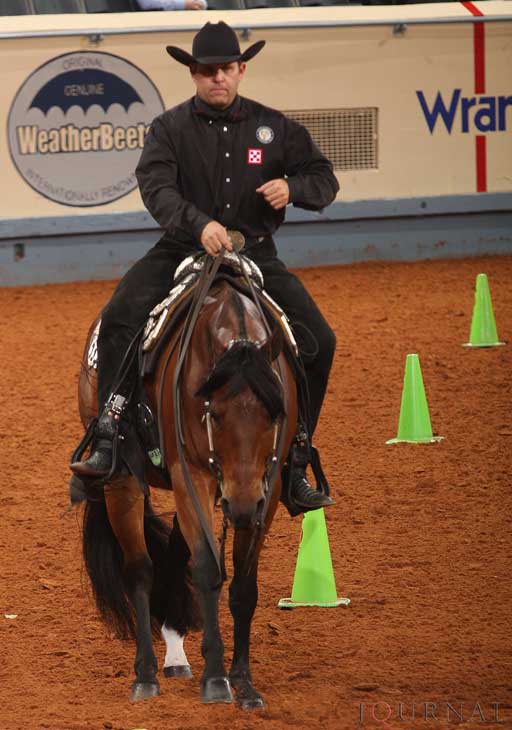In horsemanship or equitation, a good lope or canter departure will lead to a better execution of your maneuver. A good lope departure is when a horse responds to a minimal cue from the rider with willingness and collection. AQHA judge and all-around trainer Leonard Berryhill tells us how to get
your horse to do correct lope departures with minimal cues.
It’s important in every AQHA event. In western riding, it’s scored. In western pleasure, a lope departure sets up your lope. It’s much easier for a horse to carry himself after he has departed correctly than it is to have a bad departure and try to correct it as you go down the pen.
As a judge, when I see a horse depart to a lope from a jog, I consider it a bad departure if a horse increases his cadence of step at the jog and trots into the lope. But it is all right for that horse to take a step, collect himself and then depart.
From the walk, again, it is all right for the horse to take a step to collect himself, move to the rider’s cue and then step up into the lope. I expect the same thing from a stop – I think the horse has to take a half step to collect and then lope.
In the past, we allowed horses to kind of rush into the lope.
We wanted a horse to go from a dead stop into the lope, and it wasn’t as pretty as what is done today.
Why is it important that a lope departure is pretty? The word “show.” It’s a horse show, and the prettier it is, the better your performance is going to be, regardless of what class you’re in. The better departure you have, the better it’s going to look to the judges.
Common Problems
There are a lot of variables that go into a poor lope departure.
When it happens in horsemanship or equitation classes, it is typically the result of a rider who doesn’t use her cues properly to collect and prepare the horse before asking for the lope. The horse lifts his head, inverts his back, takes a few trot steps and eventually falls into the lope, instead of collecting up, gathering and loping off with some impulsion from behind.
Another possibility is that the horse could be too inexperienced or not trained well enough to do it correctly. The rider might have a too-loose rein for that horse’s ability; that particular horse might require more contact to get a correct departure; or that horse could be dull and ignoring the rider’s aids.
There are horses that just can’t perform lope departures well, even though drills can improve their abilities. A horse that tends to leave his hocks out behind and doesn’t appear to be strong in the loin or gaskin is not going to be able to lope off as well as a horse with a good, strong loin and hip.
What to Do
What makes a good lope departure different from a bad lope departure is the preparation for it. You ask the horse to collect, move off your leg, respond to your hand and then depart.
For example, if I am moving from a walk or jog into a lope, I slightly lift my hand and ask the horse to flex slightly to the inside. At the same time, I squeeze with my outside cue leg and push to the lead I’m going to ask for. I want to feel the horse move into the direction I’m pushing him. Then I ask for the lope departure with either an increased leg pressure or spur pressure and a smooch or cluck.
If it’s to the left lead, I want the horse’s hip to move to the left. I want to feel a response from the horse to my hand or leg to the left, then I apply an increased pressure, asking the horse to step into the lope.
Drills
If my horse wants to trot off into his lope, when he trots off, I immediately stop, back up, settle and then start over. Or I might stop, back, then roll back and start over.
The stopping and backing does two things: It strengthens the loin and the gaskin, and it lightens his response to the cues. It’ll teach him to stay back off that bit and lope off in response to your leg. The backing is not a punishment, it’s teaching him to respond, getting him back onto his hocks so he can collect properly to step off into the lope.
I’ll also do a lot of leg yields, teaching him to two-track, moving his hips around. Those drills work on teaching him to collect with my hand and move off my legs. All that will make the lope departure much better.
Leonard Berryhill is an AQHA judge and all-around trainer from Talala, Oklahoma. Read more on AQHA’s America’s Horse Daily.









